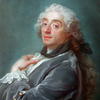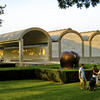More about Mercury Confiding the Infant Bacchus to the Nymphs of Nysa

Contributor
Mercury Confiding the Infant Bacchus to the Nymphs of Nysa shows Bacchus’ backstory with non-threatening aesthetics.
François Boucher was a prolific Parisian artist, best known for defining the Rococo style, or the vaporwave of the eighteenth century. His pastel-hued idyllic paintings often depicted nominally mythological subjects, although the topic usually manifests as a reason to paint scenes featuring exposed tits.
This particular painting illustrates the very early life of Bacchus (or Dionysus, in Greek nomenclature), before he becomes the god of wine and ecstatic revelry. After his birth, his father, Jupiter (or Zeus), sends the infant to be raised by the nymphs of Mount Nysa, a fictional but always-distant location representing Bacchus’ association with the exotic. This case of absentee parenting from the ruler of the gods—who isn’t even present in the painting, unless in the form of his sacred eagle next to Mercury—might raise some questions, but it has its roots in a familiar story of divine adultery and people not thinking things through.
As the tale goes, Jupiter cheated on his wife Juno (Hera) with Semele, a mortal woman of Thebes. As an equally powerful goddess, Juno naturally discovers this, and goes to Semele in disguise as her old nurse. Over the course of their girls’ night, Juno suggests that Semele’s lover is faking his godhood, and tells her to obtain proof by asking that they have sex while Jupiter is in his full, divine form.
The first mistake anyone makes here is Semele believing that nothing could go wrong with this plan. When she next sees Jupiter, she asks him for a gift, and—second mistake—before knowing what it is, Jupiter swears to grant it on the River Styx, making his promise unbreakable. He cannot deny Semele’s request to experience his true power, but he at least can try to restrain himself by picking his smallest thunderbolt to bring (it’s unclear how he plans to use it, but apparently it’s a normal part of Olympian sex). Of course, Semele is still unfortunately incinerated by the sheer power of Jupiter’s presence.
However, in prior encounters, she had become pregnant with Jupiter’s child, who, as part immortal, was unharmed, but premature. Jupiter sewed the baby into his own thigh to bring him to term, and to keep him away from Juno’s wrath, sent him to the nymphs after his second “birth” to be nursed.
While Boucher easily could’ve picked any moment in this myth to illustrate, the drama of the rest of the story (or really the majority of Bacchus’ life) was probably too much for the idyllic, pastel Rococo aesthetic. How the god got from the innocent baby he is in this painting, to the generator of iconic parties he becomes later, is only hinted by the grape- and thyrsus-wielding cherubs, and otherwise left up to our imaginations.
The idyllic scene, with only the implication of mythological debauchery, certainly appealed to many later patrons—both legitimate and illegitimate. After being passed through generations of Paris’ elite mansions, the painting ended up in the Rothschild’s Hôtel de Pontalba. It remained safely there, in the Jewish banking family’s massive art collection, until 1940 with the German invasion of France. For obvious reasons, the family fled the country, and the occupying Nazis used the excuse that Jewish people were no longer citizens to justify seizing their property. Such confiscation happened throughout the war; Nazis destroyed or sold off “degenerate” art (i.e. anything too modern, abstract, and “decadent”), and saved pieces they thought represented the opposite, to eventually be displayed publicly as part of Hitler’s and Göring’s collections of idealized German art. The Nazis sought out old master paintings, medieval German art, and eighteenth-century French pieces such as this one. However, before the Nazis could realize their dreams of having a massive compendium of stolen art representing their alleged cultural superiority, World War II ended with the Axis’ defeat, and this painting, among many others, was returned to its original owners.
Sources
- Stein, Perrin. “François Boucher (1703–1770).” Heilbrunn Timeline of Art History. The Metropolitan Museum of Art. 2003, http://www.metmuseum.org/toah/hd/bouc/hd_bouc.htm.
- Atsma, Aaron J. “Dionysus: Mount Nysa, Birthplace of Dionysus.” Theoi Project. http://www.theoi.com/Olympios/DionysosMyths.html#Nysa.
- Ovid, Metamorphoses. Translated by Charles Martin. New York: W. W. Norton & Co., 2004, III.328-406.
- Rothfeld, Anne. "Nazi Looted Art." The Holocaust Records Preservation Project. Issue 34, no. 2 (2002). Accessed June 15, 2018. https://www.archives.gov/publications/prologue/2002/summer/nazi-looted-….











